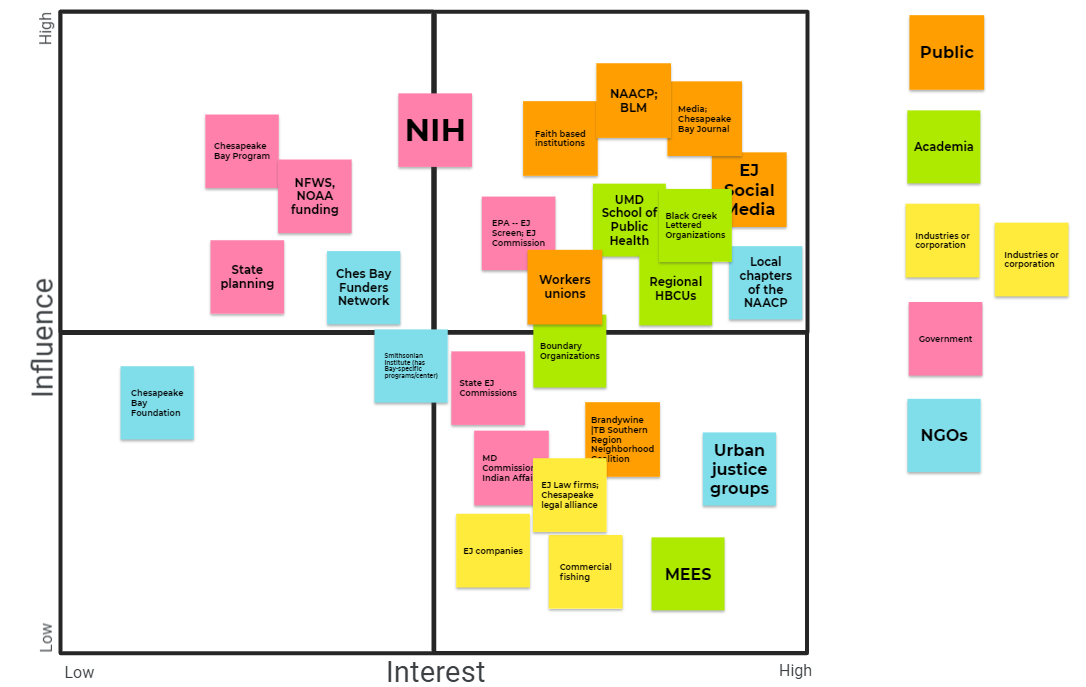Academic Entrepreneur
Haoyu (Peter) Chen ·When reviewing the two successful businesses I have created recently, I thought about why they are successful. Through the special campus environment under COVID-19, the businesses provided special delivery services to many students who were stuck at home. Based on this, we have established a team and gradually expanded to more services. With the success of the businesses I earned several times the return of my initial investment, with a constant income everyday. Every business usually has three important attributes: product, channel, and customer. Among them, the most important thing I deeply believe in is your customers. Not all products will be as unique or successful as Steve Jobs’ Apple products, so you should spend a good amount of time thinking about who your customers are and what their demand is. Similarly, the same idea can be applied to the study of environmental justice (EJ) and to tools used to facilitate the studying of EJ.

Who are your customers?
Stakeholder mapping, a tool for locating stakeholders, was introduced by last week's lecturers to the MEES 718 class. Stakeholder mapping displays all the stakeholders related to your project, business, and product through visualization. In a good stakeholder mapping, all stakeholders who may have an impact are included. Through integration, you can conceptualize your stakeholders and then prioritize them to lead future actions (Walker et al. 2008). In a business example, let’s imagine you receive regular emails from a website that you have registered for as a member. That is a specific action to keep your interest for the future. As a member, you have the possibility to become a powerful person to them in related events! In either a business or a stakeholder setting we can use such a map to clarify several questions: Who owns the resources? Who has influence? Who will benefit the most? How can our plan be implemented?

Socialize with stakeholders
The theme of MEES 718 is to develop the Environmental Justice indicator for Chesapeake Bay. Interestingly, the method used in determining the stakeholders for this indicator has a lot of similarities with a social network study. Crona & Bodin et al. (2006) used social network techniques to study the relationship between fishery resources and the structure of coastal communities on the beach of Kenya. Through the questionnaire survey, each person’s relationship with other people in the community was sorted out (e.g. Who do you communicate with when you encounter a certain situation? Why?). The research mostly indicated that a lack of communication limits the protection of regional resources. Groups with knowledge of ecosystem management did not share knowledge with other members of the community in a timely manner. Additionally, the ecology of different fish species, fishing methods, and other knowledge were only known by some fishermen, resulting in initiation of the appropriate collective action not by favorably positioned actors.
Similar to this case study, when developing EJ indicators of Chesapeake Bay, maintaining long-term communication can also let stakeholders know what the purpose of the project is, which parties are currently participating, what kind of resources are needed to assist us, and how they can benefit in the end. These can ensure the rationality and universal applicability of the final decision for the EJ indicator. According to the previous classification of stakeholders, we will need to carry out different levels of communication and information sharing. Whether as a business with clients or in dealing with project stakeholders, it is very important to build trust, especially with powerful and interested parties.

Develop our product
In the end, a successful project, or business, often has an attractive product. After identifying important EJ indicators of Chesapeake Bay, the class's favorite indicators were selected and studied, such as hazards and social and biological indicators, to develop our version of EJ screen. But challenges still exist: Are the indicators we choose updated and representational enough to show our stakeholder 'customers' (some may be outdated)? What level of content do we need for us to get their support? What kind of support can we get in return to improve the final product? In the next few weeks, we will all communicate with our stakeholders and establish relationships with them. This stage of the EJ indicator process reminds me of a quote that modern Chinese literature writer Lu Xun wrote, “There is no road in the world, if you walk too much, it becomes a road” (Lu Xun, 1923). Although there will be many difficulties in the process of developing the EJ indicator, we still have confidence and good expectations that the final results can truly serve the public and provide a backing for the "my life matters" movement and others who need EJ.
References
Crona, B., & Bodin, Ö. (2006). What You Know is Who You Know? Communication Patterns Among Resource Users as a Prerequisite for Co-management. Ecology and Society, 11(2). Retrieved March 31, 2021, from http://www.jstor.org/stable/26266000
EPA. (2021). EJSCREEN: Environmental Justice screening and mapping tool. Retrieved from https://www.epa.gov/ejscreen
Lu Xun. (1923). Call To Arms: Hometown. Beijing Xinchao Press.
Savina, A. (2019). Complete stakeholder mapping guide. Retrieved from https://miro.com/blog/stakeholder-mapping/
Walker, D. H., Bourne, L. M., & Shelley, A. (2008). Influence, stakeholder mapping and visualization. Construction management and economics, 26(6), 645-658.
About the author
Haoyu (Peter) Chen

Haoyu (Peter) Chen is a first year master’s student in the University of Maryland’s Marine Estuarine Environmental Sciences program, with a concentration in cell & molecular biology. He is advised by Dr. Chen Feng studying the mechanism of cold adaptability of Synechococcus, a widespread phytoplankton in marine, during winter. In addition, Haoyu is also interested in biodiversity using molecular methods. Recently, he is working to understand the systematics of hydrozoa, a benthic stage of jellyfish, near the coast of China.
Next Post > Facilitating a Great Barrier Reef partnership workshop in Brisbane
Comments
-
Katrina Kelly 5 years ago
This is a perfect analogy, Haoyu. I like your emphasis on LEK conceptualization for a more effect product, in our case, a report card that is the result of a carefully integrated knowledge ecosystem and a focus on customer needs. Congratulations on the success of your businesses. A clear illustration that good CRM (customer relationship management) is applicable in a variety of contexts.
-
Isabel 5 years ago
I love how you framed this blog! Our class has many different steps in addressing stakeholders that you convey here. I specifically like that you mention the importance of speaking with stakeholders over time. This connection is vital if we want to keep a positive relationship with people residing in these areas of Environmental Injustices.
-
Taylor Gedeon 5 years ago
Wow I agree with Katrina and Isabel, the analogy you used was great. It is important to consider the power imbalances that exist between identified stakeholders and how those might play out in a discussion like environmental justice mapping. Different values and priorities will influence stakeholder groups to prioritize work for their best interest, so I agree that it is crucial to fully and continuously engage with stakeholders, especially those directly harmed and impacted.
And congratulations on your successful businesses! -
Amber 5 years ago
Very interesting and captivating perspective on how we engage people in this process and the usage of the final tool. I agree with your emphasis on continuing to engage with stakeholders. We must ensure that what we are producing is reflecting their experiences and capturing the appropriate components.
-
Chelsea Richardson 5 years ago
As you stated, it is important to make sure the stakeholders are engaged. With their engagement, stakeholders provide their diverse perspective/knowledge that will help to create a better environmental justice report card for the Chesapeake Bay.
-
Faith Taylor 5 years ago
I like the comparisons you make here. If the report card is product we need to make sure that consumers want it!
-
Andrea M Miralles-Barboza 5 years ago
These are great points Peter, not just considering science comm and more scientific thinking but also how is this marketed and interesting to every day people. Thanks for this insightful blog and for the cool photo!
-
Olivia 5 years ago
I really enjoyed learning about your own business experiences and how that can connect to our understanding of stakeholder engagement for the class! It will definitely be essential to have stakeholder input on the indicators in future iterations of this project.
-
Jehnae Linkins 5 years ago
Katrina said it all, the analogy was well said and very impactful. I think your business experiences are pretty dope! It is great that you are thinking about how to engage stakeholders.
-
Sarah 5 years ago
As many of the other commenters have stated, I really liked how you incorporated your business experience into how we need to go about engaging stakeholders. I also want to emphasize how you incorporate the challenges that we face with our indicators and the engagement of stakeholders in the future. Acknowledging challenges is the first step towards solving them.
-
Imani Black 5 years ago
What a great blog! Congrats on your business venture and sharing you experience within that with us. It was very engaging and I liked getting to step into of your world so many miles away as you tied it back to environmental justice.
-
Ashley Silver 5 years ago
I like the connection you made in regards to successful businesses and engaging stakeholders to establish indicators for the Chesapeake Bay watershed report card.
-
Shakira 5 years ago
Haoyu, this was well put and as others have said I liked your analogy. It was nice reading how you incorporated the topics from class to your personal life and business experiences.
-
Imani Wilburn 5 years ago
Wow! Not only did this enlighten me on things I never considered, but it also gave me an insight into you! This comparison is so perfect, there couldn't be a better one. The into was not what I was expecting at all, but totally grabbed my attention immediately. The way you described stakeholders and engaging with them and even identifying them was so enlightening and will definitely help me in the future.
-
Nylah McClain 5 years ago
This way of thinking does make it easier to visualize how to market our index to those individuals who may not immediately benefit from it’s use. Especially after hearing Robert Summers specify that privileged parties will have to be included for progress to be made, it may be easier for us to handle.

